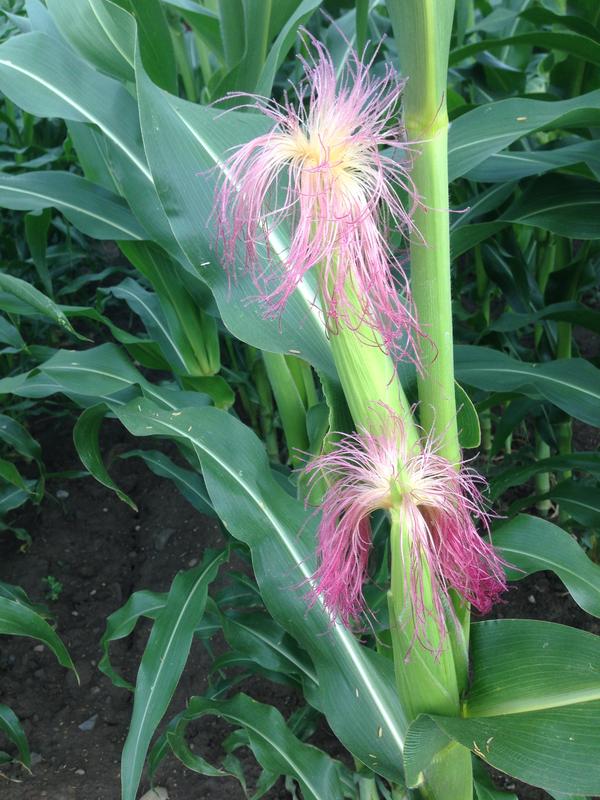Precision breeding needed to adapt corn to climate change, ancient samples show

Female flowering in one of the landrace hybrid Credit: Kelly Swarts
From this point onwards, it grew well enough to provide a reliable source of subsistence, mainly in stews and soups. Its nutritional content was also improved – the study finds that some of the archaeological samples had high beta-carotene yellow kernels, the earliest evidence of people eating yellow corn. The kernels were also likely to be of the popping variety.
Farmers adapted it using the genetic diversity of domesticated varieties and wild grass relatives already present in Mexico. Over time, their selections meant that varieties became dominant for gene variants that drive early flowering, enabling them to cope with a shorter growing season and different day-lengths. This took millennia to accomplish.
“We see incredible genetic variation in maize, but it took a long time to accumulate enough of the early flowering variants in the same plant to adapt to short growing seasons. A trait like flowering time is so complex that it involves changes to hundreds of genes,” says Kelly Swarts from Cornell University and now at the MPI for Developmental Biology.
The samples reveal that the first maize successfully adapted to grow in a temperate climate was short, bushy and was likely a pop-type corn compared to modern varieties, or landraces. The authors find that it helped lead to all temperate US and European maize grown today.
“Our findings show that because of its genetic diversity maize has the ability to adapt to just about anything that’s thrown at it” says Swarts. “But we won’t have the luxury of millennia to adapt maize to the environmental challenge of global warming and will need precision breeding, for example with genome-edited crops, to rapidly develop new varieties. Maintaining diversity in traditional maize landraces is also important. Precision breeding holds great promise, as long as we have a good understanding of what to target by studying the widest possible diversity.”
The scientists studied 15 maize samples extracted from fossilized maize cobs discovered in a dry cave shelter known as Turkey Pen in Utah’s Grand Gulch canyon.”It was very exciting to carry out the first genetic analysis of the samples since their excavation in the 1970s,” says Hernán Burbano from the MPI for Developmental Biology. “The samples were very well-preserved in this dry environment. Although DNA fragments were short, in some samples up to 80% of the retrieved fragments were maize DNA with only a minor fraction of microbial origin. Consequently, it was possible to characterize genetic variation in each sample across the whole genome,” he says.
The authors gathered information from thousands of modern inbred maize varieties. To predict flowering in the long-dead archaeological samples, they compared the genomes of ancient and modern strains. To test whether their predictions were accurate, they developed populations from descendants of the ancient varieties and grew them to observe when they flowered.
The validation showed that the initial predictions were highly accurate. Future studies of archaeobotanical crop samples could now use the same methods. “It wasn’t thought possible to pinpoint a trait like flowering time from archaeological samples and it’s only because of recent advances in both ancient and modern genomics that we’ve been able to generate these new insights,” says Swarts.
The study was funded by the National Science Foundation in the US and the Max Planck Society in Germany. It will be published on Friday 4th August in Science.
http://science.sciencemag.org/cgi/doi/10.1126/science.aam9425
Media Contact
More Information:
http://www.fml.mpg.deAll latest news from the category: Life Sciences and Chemistry
Articles and reports from the Life Sciences and chemistry area deal with applied and basic research into modern biology, chemistry and human medicine.
Valuable information can be found on a range of life sciences fields including bacteriology, biochemistry, bionics, bioinformatics, biophysics, biotechnology, genetics, geobotany, human biology, marine biology, microbiology, molecular biology, cellular biology, zoology, bioinorganic chemistry, microchemistry and environmental chemistry.
Newest articles

Combatting disruptive ‘noise’ in quantum communication
In a significant milestone for quantum communication technology, an experiment has demonstrated how networks can be leveraged to combat disruptive ‘noise’ in quantum communications. The international effort led by researchers…

Stretchable quantum dot display
Intrinsically stretchable quantum dot-based light-emitting diodes achieved record-breaking performance. A team of South Korean scientists led by Professor KIM Dae-Hyeong of the Center for Nanoparticle Research within the Institute for…

Internet can achieve quantum speed with light saved as sound
Researchers at the University of Copenhagen’s Niels Bohr Institute have developed a new way to create quantum memory: A small drum can store data sent with light in its sonic…





















